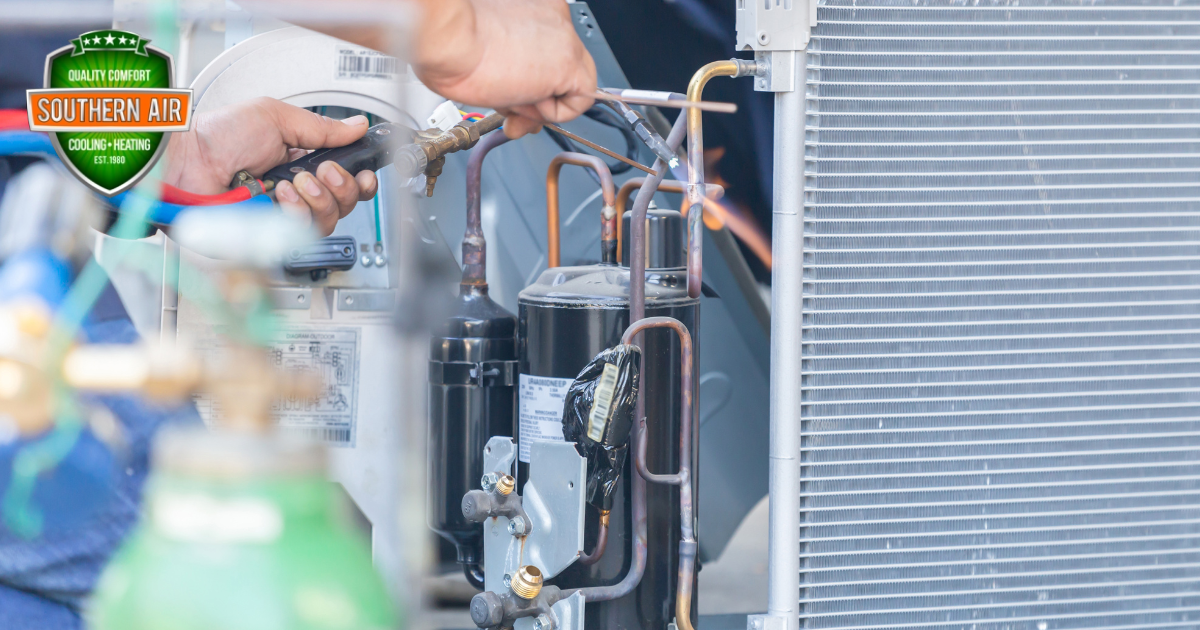Stepping into a home that rejects the embrace of cool air during a sweltering day is akin to opening a novel only to find the first page blank; both scenarios leave you yearning for what should have been a comforting respite. Your AC’s refusal to start is not just an inconvenience but a silent scream for attention, where each component from the capacitor to the thermostat plays a pivotal role in this complex ballet of cooling.
Initial Steps When Your AC Won’t Turn On
Embarking on a quest to coax your silent AC back to life begins with a few crucial, yet often overlooked steps.
First, shine a light on the lifeline of your system—the power supply. Ensure that the unit is not only plugged in but also that the sanctity of the power cord and outlet remains unviolated.
Next, your thermostat demands scrutiny; it should whisper “cool” to your AC in a language it understands, with settings dipped below the current embrace of room temperature.
Should your home resemble a ship lost at sea, reset the circuit breaker, a beacon that may have unwittingly dimmed, plunging your cooling companion into darkness.
Lastly, like a detective at a crime scene, inspect your AC for any telltale signs of damage—these initial steps are the cornerstone of your troubleshooting odyssey.
Verify the Power Supply to the Unit
Before surrendering to the silence of an AC that refuses to stir, ensure its lifeline remains unsevered. A disconnected power supply is often the silent thief of comfort, robbing your space of the cool embrace it seeks. Unearth the root of this electrical enigma by investigating the power path: from the wall outlet, through the intricate dance of wires, to the heart of your system. Every junction holds a clue, with the circuit breaker standing as the gatekeeper between order and chaos. Should this guardian be swayed by a power surge, it may trip, cloaking your unit in an unwelcome silence. Resetting it might just be the key to reviving your guardian and, with it, the breath of your AC.
- Illuminate the shadowed corners behind your AC, ensuring it’s securely plugged into the embrace of its outlet.
- March to your circuit breaker or fuse box, your steps echoing with the purpose of a troubleshooter determined to rekindle a lost connection.
- Confront the breaker or fuse box, the silent sentinel of your home’s electrical flow, to unveil any signs of a tripped breaker or a fuse that whispers tales of burnout.
Inspect the Thermostat Settings
Peering into the heart of your system’s responsiveness, the thermostat stands as a digital gatekeeper, orchestrating the symphony of comfort within your abode. This guardian of temperature and herald of cool breezes may hold the secret to the silence of your AC: settings that have strayed from their designated path. Ensuring it speaks the cool command, set below the room’s current caress, may reawaken your system from its slumber.
- With a steady hand, guide your thermostat from the ambiguity of its settings to the clarity of ‘cool’ mode, a subtle language it comprehends.
- Adjust the temperature, a notch below the warmth that pervades your space, inviting the cool whispers of air once more.
- For those wielding a programmable thermostat, navigate through its schedule with the precision of a cartographer, ensuring it aligns with your quest for coolness.
How to Troubleshoot the Thermostat
Beyond its digital command, the lifeblood of your thermostat—its batteries—may have succumbed to the passage of time, demanding a swift replacement to awaken its slumbering interface. Beneath the surface, a layer of dust might cloak its sensors, a veiled obstruction that distorts its judgment and calls for a gentle, cleansing touch.
Finally, a probe into the labyrinth of wires within reveals the naked truth: only a secure and untarnished connection can sustain the whisper of cooling comfort through your abode.
Each of these facets, intricately woven into the operational tapestry of your thermostat, demands attention, ensuring the breadth of your AC does not falter at the threshold of warmth.
Inspecting and Resetting Circuit Breakers
The electrical panel, a nexus of power and protection, often holds the key to unlocking the silence of an AC unit that stands unresponsive. By locating your home’s electrical panel, you wield the capacity to delve into the realm of circuit breakers, where the fate of your cooling system may hang in the balance.
Identifying and resetting the specific breaker dedicated to your AC can prove a decisive step, while vigilance in monitoring for frequent tripping offers a glimpse into potential underlying issues demanding attention.
This exploration is not merely about flipping switches; it’s an essential stride towards re-establishing the harmony of cool air flowing through your domain.
Cleaning or Replacing Air Filters
Embarking on the quest to revive your silent air conditioning system, attention now shifts to a critical, yet often underestimated protagonist: the air filter. This guardian of air quality and flow within your sanctuary plays a pivotal role in the functionality of your AC system.
Before you navigate the labyrinth of ducts and vents on a rescue mission, understanding how to locate your air filter is essential.
Equipped with this knowledge, you’ll then be ready to either rejuvenate a reusable filter back to its former glory or judiciously decide when it’s time to replace it with a fresh counterpart.
The Importance of Checking Condensate Drain Lines
When the quest to revive a non-responsive AC system takes you deep into its inner workings, the condensate drain line emerges as a critical, yet often overlooked, battleground. This conduit, responsible for whisking away condensation produced during the cooling process, can become the Achilles’ heel of your system if ignored.
A clog within this pipeline not only threatens the efficiency of your unit but can also lead to potentially severe water damage or mold growth in your hideaway.
Initiating your troubleshooting odyssey with a thorough examination of this component—locating your AC’s drain line, mastering the art of clearing any obstructions, and strategizing on preventing future clogs—can dramatically shift the tides in favor of restoring your sanctuary’s peace and coolness.
When to Call a Professional for Assistance
In navigating the labyrinthine intricacies of an AC system that stubbornly refuses to power on, you’ll often find yourself at a crossroads where the line between a DIY venture and the need for professional intervention becomes blurred.
Recognizing the symptoms that beg for a technician’s touch, selecting the right expert for the job, and preparing essential information for the service call stand as critical steps in the ballet of AC repair. These actions not only ensure a smoother resolution but also protect your investment from the potential pitfalls of misdiagnosis.
Whether it’s an unyielding noise, an enigmatic error code, or a compressor that’s seized in silence, discerning the right moment to call in a cavalry of expertise could be the decisive move that restores comfort and functionality to your domain.
Symptoms That Require a Technician
When your air conditioning system remains silent despite your best troubleshooting efforts, it becomes crucial to acknowledge the signs that scream for a professional’s attention: perplexing noises that speak of internal despair, an incessant drip that tells tales of a condensate line defeat, or the enigmatic blinking of error codes, cryptic messages only a skilled technician can decipher. These are the harbingers that signal the need to step back and entrust your cooling sanctuary’s revival to an expert, whose tools and knowledge navigate the tightrope between malfunction and restoration.
- Listen for unusual noises that betray the internal turmoil of your AC unit.
- Monitor for persistent leaks or water issues, suggesting a condensate drainage problem.
- Heed the cry of error codes flashing on the thermostat or indoor unit, each a Morse code needing expert translation.









